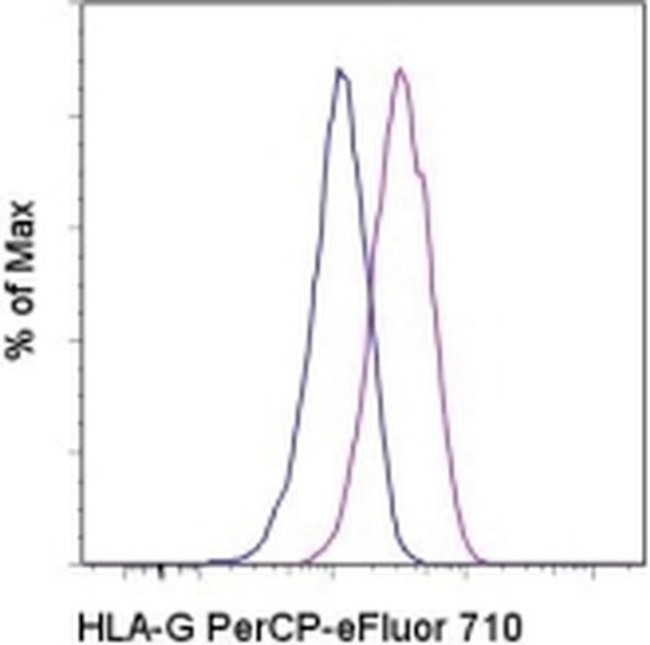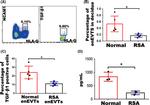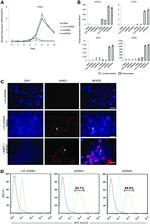Search
Invitrogen
HLA-G Monoclonal Antibody (87G), PerCP-eFluor™ 710, eBioscience™
{{$productOrderCtrl.translations['antibody.pdp.commerceCard.promotion.promotions']}}
{{$productOrderCtrl.translations['antibody.pdp.commerceCard.promotion.viewpromo']}}
{{$productOrderCtrl.translations['antibody.pdp.commerceCard.promotion.promocode']}}: {{promo.promoCode}} {{promo.promoTitle}} {{promo.promoDescription}}. {{$productOrderCtrl.translations['antibody.pdp.commerceCard.promotion.learnmore']}}
产品信息
46-9957-42
种属反应
已发表种属
宿主/亚型
分类
类型
克隆号
偶联物
激发/发射光谱
形式
浓度
纯化类型
保存液
内含物
保存条件
运输条件
RRID
产品详细信息
Description: The monoclonal antibody 87G recognizes human HLA-G, a member of the Human Leukocyte Antigen family but as part of the nonclassical MHC type involved in inhibiting immune reponses. HLA-G has seven reported isoforms. The antibody 87G recognizes both HLA-G1 and the solube HLA-G5. Expression of HLA-G is found primarily in fetal trophoblast cells as they invade the maternal decidua thereby protecting the fetus from the maternal immune system. Like the highly mitotic trophoblast, abundant HLA-G protein expression has been identified in some tumors, including melanoma, breast carcinoma and renal carcinoma as well as CLL, AML and B-CLL. Some expression has also been found in pancreatic islets, erythroid and endothelial progenitors and the adult thymic medulla.HLA-G+ CD4 or CD8 cells have been identified in normal human peripheral blood and are thought to act as regulatory cells in that they are hypoproliferative with a unique cytokine profile differing from Tregs. The receptors for HLA-G are CD85j/ILT2, CD85d/ILT4, and CD158. Recent studies have shown a role for HLA-G in tolerance and maintenance of transplanted organs.
Applications Reported: This 87G antibody has been reported for use in flow cytometric analysis.
Applications Tested: This 87G antibody has been pre-titrated and tested by flow cytometric analysis of stimulated monocytic cell line. This can be used at 5 µL (0.125 µg) per test. A test is defined as the amount (µg) of antibody that will stain a cell sample in a final volume of 100 µL. Cell number should be determined empirically but can range from 10^5 to 10^8 cells/test.
PerCP-eFluor® 710 can be used in place of PE-Cy5, PE-Cy5.5 or PerCP-Cy5.5. PerCP-eFluor® 710 emits at 710 nm and is excited with the blue laser (488 nm). Please make sure that your instrument is capable of detecting this fluorochrome. For a filter configuration, we recommend using the 685 LP dichroic mirror and 710/40 band pass filter, however the 695/40 band pass filter is an acceptable alternative.
Our testing indicates that PerCP-eFluor® 710 conjugated antibodies are stable when stained samples are exposed to freshly prepared 2% formaldehyde overnight at 4°C, but please evaluate for alternative fixation protocols.
Excitation: 488 nm; Emission: 710 nm; Laser: Blue Laser.
Filtration: 0.2 µm post-manufacturing filtered.
靶标信息
HLA-G belongs to the HLA class I heavy chain paralogues. This class I molecule is a heterodimer consisting of a heavy chain and a light chain (beta-2 microglobulin). The heavy chain is anchored in the membrane. HLA-G is expressed on fetal derived placental cells. The heavy chain is approximately 45 kDa and its gene contains 8 exons. Exon one encodes the leader peptide, exons 2 and 3 encode the alpha1 and alpha2 domain, which both bind the peptide, exon 4 encodes the alpha3 domain, exon 5 encodes the transmembrane region, and exon 6 encodes the cytoplasmic tail.
HLA and MHC antibodies play a significant role in Immunopeptidomics, facilitating the identification and characterization of neoantigens through high-performance liquid chromatography coupled to tandem Mass Spectrometry.
仅用于科研。不用于诊断过程。未经明确授权不得转售。
How to use the Panel Builder
Watch the video to learn how to use the Invitrogen Flow Cytometry Panel Builder to build your next flow cytometry panel in 5 easy steps.
生物信息学
蛋白别名: b2 microglobulin; DADB-15K14.8; HLA class I histocompatibility antigen, alpha chain G; HLA class I molecule; HLA G antigen; HLA-G histocompatibility antigen, class I, G; MHC class I antigen G
基因别名: HLA-6.0; HLA-G; HLAG; MHC-G
UniProt ID: (Human) P17693
Entrez Gene ID: (Human) 3135








